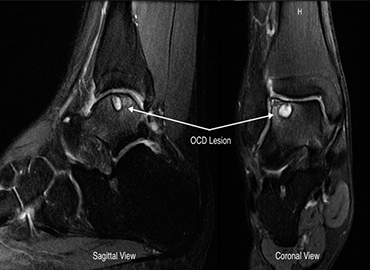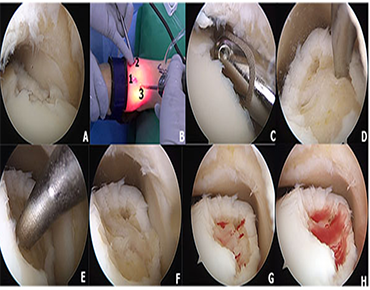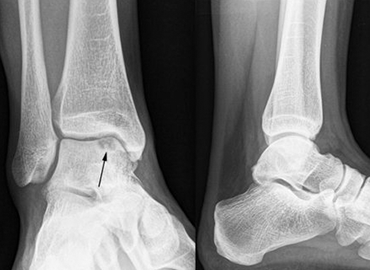Talar OCD
Home / Talar OCD
Talar OCD
Get AppointmentTalar OCD
Osteochondritis Dessicans or OCD is a medical condition of the ankle that exists in the talus bone where the cartilage and the bone lying under it are damaged. OCD is also called Osteo Chondral Lesions. The injuries include the cartilage layer blistering, cyst-like lesions within the bone, or fracture of the cartilage and bone layers. It happens without obvious cause (idiopathic) or it can happen after an injury as well.
Causes
The cause of most cases of OCD is thought to be actual chip-type fractures. These fractures occur with severe ankle sprains. Which side of the talus the chip is on depends on how the ankle was twisted during the initial injury.
The chip fracture can vary in size and severity. If the bone underneath the cartilage is crushed or cracked and the articular cartilage is intact, the fragment is less likely to move. If the articular cartilage is broken as well, the bone fragment may move out of position or displace, making healing less likely and later problems more likely.
Symptoms
The Symptoms are
- Pain in the ankle
- Difficulty in walking, running, and playing sports.
- Mechanical symptoms like locking, loose body sensation, and instability.
Diagnosis
The Doctor will ask you a series of questions about the severity and origin of the injury, as well as your medical history. Then they will perform a physical exam to check your range of motion and pain levels, which may cause minor and brief discomfort.
After the physical exam, your doctor will likely order diagnostic tests such as X-rays and MRIs to rule out other potential conditions. Once we have this information, the doctor will talk to you about your options and create a custom treatment plan for your condition.

Treatments
Non-Surgical Methods
The different non-surgical treatment options are:

- Rest: Giving proper rest to the ANKLE is the first step towards recovery. The patient is recommended to stay away from sports or strenuous activity.
- Plaster: Plaster or a walking boot is recommended by doctors to relieve the symptoms by providing support to the ankle.
- Non-Steroidal Anti-Inflammatory Drugs (NSAIDs): NSAIDs drugs like Ibuprofen etc., can help reduce pain and swelling.
- Physical Therapy: It is usually recommended with exercises for muscle strengthening and to reduce stiffness and increase flexibility.
Surgical Methods
Indications for surgery are pain, limited activities, mechanical symptoms like locking in the ankle, and restriction of movements.
The surgery is performed in order to restore the Talus bone’s normal shape and gliding surface so that the normal mechanics and joint forces are re-established. Thus, minimizing the symptoms and limiting arthritis. The surgical treatments will include Debridement or removing the damaged bone and cartilage, fixing the injured fragment, micro-fracture or drilling of the lesion, and bone & cartilage grafting. The best option is the Ankle Arthroscopy technique to perform the different treatments.
Ankle Arthroscopy

This is a minimally invasive surgical procedure performed to diagnose and treat problems in the ankle joint.
Basically, the doctor will make a very small incision and insert the Arthroscope, a tiny camera, into your ankle enabling them to view the inside of the joint on the screen. The surgeons will then investigate the issue with the ankle and decide on the type of procedure needed, depending on the size of the lesion and symptoms.
The loose fragments of bone and cartilage will be removed and The defect’s base is then drilled with fine wires or micro-fractured, creating small holes and channels to allow tiny blood vessels to grow and improve the blood supply to the talus. Or a bone marrow aspirate rich in stem cells is injected along with glue to stimulate the healing of new cartilage and rarely a cartilage biopsy is done and sent to a laboratory to grow and re-implanted later is called autologous chondrocyte implantation can be done.
Ankle Stem Cell Treatment
This is an alternative to most of the traditional approaches to Ankle joint pain treatment. If these cells are placed in a certain environment, they transform themselves to suit that environment. For instance, stem cells placed near damaged cartilage will develop into cartilage tissue later on.
The common type of stem cells used for treating arthritis is called Mesenchymal Stem Cells. They are usually collected from a patient’s fat, blood, or bone marrow. This process of collecting stem cells is called Harvesting.
This treatment basically extracts stem cells from an area of high density and then injects them into the damaged is to help heal the body naturally.
GET APPOINTMENT
Schedule Appointment : Your Path to Specialized Care
Get rid of your pain, stress, and enduring with our 24/7 dental services. It's a priority to relieve the pain in surgeon as much as possible. 90% of customers claim that they would come back & recommend us to others.
